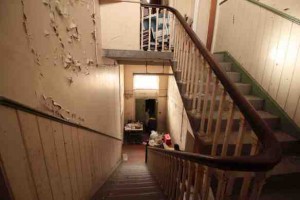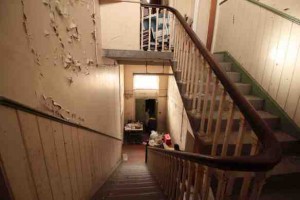In Donnybrook, Future of Crumbling Magdalene Laundry Is Uncertain
By Louisa Mcgrath
Flynn says this untouched laundry would give the state an opportunity to record what exactly went on in these institutions. As he sees it, it is not just about the memory of Magdalene laundries, it’s also about a swathe of religious and state institutions: mental institutions, psychiatric hospitals, mother-and-baby homes, industrial schools, reform schools. They’re all interconnected, he says. Flynn went inside the buildings and saw the dormitories and the laundry rooms. Irons, baskets, sinks, ledgers, suitcases, furniture, religious statues and industrial machines all remain intact, he says. As does the atmosphere. One of the baskets was labelled, “Aras an Uachtarain, Phoenix Park”. It seems that the sheets of former presidents were washed there. Flynn is adamant that everything should remain together on the site, rather than some artefacts being put in museums. “It’s not about items,” he says. “It’s about the intact site. It’s about a landscape and memory that’s intact.” The idea of a museum on par with the tenement museum on Henrietta Street doesn’t appeal to him. That would be too artificial, he says, it simply needs to be preserved, rather than forgotten. In Private Hands But right now, the state does not own the site. The Sisters of Our Lady of Charity, who still own the convent beside the site, sold the laundry to a private owner years ago. Flynn’s aim with the petition is to make the state aware of the situation, so that it might acquire the property. He believes it’s up to Dublin City Council’s conservation officers, the Office of Public Works, An Taisce and the Civic Trust to assess the building. However, according to Flynn, the owners did not respond to communications from state officer wanting to view the site. The owners could not be reached for comment. The chimney stack on the site has had a preservation order since 2012, as a way of honouring the women who were forced to work there. Labour Dublin city councillor Dermot Lacey, who lives near the site, proposed the addition at the time, and now he supports the preservation of the whole site. He says it would be an appropriate memorial.
“If we can find the money to preserve it,” he says. “I can gather it would be about ˆ2-3 million.” Lacey says he walked through the Donnybrook laundry more than a year ago, and found the experience eerie. “To be honest with you, you can almost feel the women’s presence,” he says. He’d like to see a non-political body make use of the building if it is bought by the state. He wrote to the National Women’s Council of Ireland to suggest that it take on the project. The large hall could be used for conferences, he says, and this could, in turn, fund some sort of educational museum. Remembering Through Research On Sunday, survivors and the families of survivors gathered at Glasnevin Cemetery to remember the women who had died in the laundries. The annual event, which usually takes place close to International Women’s Day, fell on Mother’s Day this year. After Taoiseach Enda Kenny apologised to the victims of the Magdalene laundries three years ago, Justice for Magdalenes (JFM) began to focus on researching the Magdalene laundries. On Sunday, it presented some of its work which, for the most part, contradicted the findings of the McAleese report, an investigation into state involvement in the Magdalene laundries. By looking at the electoral register for the Donnybrook laundry in 1954 and again in 1963, the group determined that 63 percent of the women there at that time were imprisoned there for a minimum of eight years. (Contrary to figures in the McAleese report.) By visiting the five grave sites of those who died in Magdalene laundries around Dublin, it was clear that little care had been taken in their burials. It’s unclear who lies in some graves. Other graves have names on the gravestones of people who aren’t buried there. (Though those who died in the Donnybrook laundry are buried on site.) Figuring out where each woman is buried is a big part of JFM’s research, as is getting together a list of the women who died. This can prove difficult, as the charity doesn’t have access to the church’s records. It has also collected the oral accounts of 90 survivors, like Sara W, and 4,000 pages of archive material. Soon a digital “museum” will be available online. This is all about preserving and recording this horrendous part of Ireland’s social history. “It’s about ensuring there’s a memory, a legacy to make sure it doesn’t happen again,” said Claire McGettrick, a spokeswoman at the event. “We need to learn. We need to understand. It hasn’t hurt enough to stop it from happening again.” Abuse in state institutions is still going on, she said. What Do Survivors Think? One survivor of High Park laundry — who preferred not to be named — would like to see the site preserved. “The Germans preserved Auschwitz,” she said at Sunday’s commemorations. “It would be a reminder. The state and the nuns should never be allowed forget what happened.” McGettrick points out that already this year, a Magdalene laundry in New Ross was bulldozed despite recommendations that the government’s ex-gratia scheme for survivors include commemoration of the Magdalene laundry’s history. And it is not like it is short of funds. She says that more than half of the ˆ58 million allocated to the Magdalene scheme is still available. But the JFM isn’t dead-set on preserving the Donnybrook laundry. One option, she says, might be to take the artefacts, and records and house them in the Magdalene laundry on Sean McDermott Street, which is already in the possession of Dublin City Council. Elizabeth O’Dwyer, another survivor who spent time in a couple of laundries, is also unsure about what should become of the Donnybrook site. “I don’t know to be honest,” she said, pausing to think. “It’s a terrible place.” Though she was never in the Donnybrook laundry, she says, if you’ve been in one you’ve been in them all. She seems to make up her mind. She’d rather the laundry not be saved. “Not with my opinion of them anyway,” she says. Instead, she’d prefer to see it turned into something useful, somewhere where people can live.
|
.
Any original material on these pages is copyright © BishopAccountability.org 2004. Reproduce freely with attribution.

